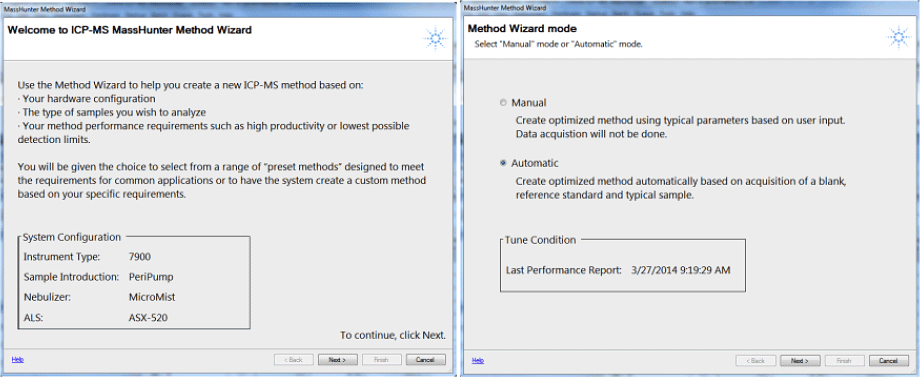Access Agilent eNewsletter, July 2014
>> Update My Profile | Subscribe to Access Agilent | Article Directory

Simplify ICP-MS method development with an Automated Method Wizard for analysis of food certified reference materials
By Kazuhiro Sakai, Junichi Takahashi
Agilent ICP-MS Applications Specialists
and Ed McCurdy
Agilent ICP-MS Product Marketing
In food analysis, as the potential toxicity of trace elements becomes better understood, the trend is for a wider range of elements to be monitored, and for the regulated levels to decrease. As a result, many food laboratories are now considering or already using inductively coupled plasma mass spectrometry (ICP-MS) for these measurements.
The implementation of ICP-MS creates several challenges for laboratories that are currently using more traditional and well-established techniques for metals analysis. Trace level analysis requires tighter control of general laboratory practices to ensure that low detection limits can be achieved routinely. ICP-MS is also generally considered more difficult to learn and use than the well-established inductively coupled plasma – optical emission spectroscopy (ICP-OES) and atomic absorption spectrometry (AAS) techniques, especially in more complex method development for new sample types. Selection of suitable analyte isotopes and internal standard elements requires some experience, while identifying and overcoming potential interferences requires an understanding of mass spectrometry. The introduction of collision reaction cell (CRC) technology for ICP-MS makes it possible to eliminate most common polyatomic interferences that occur in the samples typically encountered in a food laboratory, but choosing the optimum cell gas mode for trace level analysis also requires some expertise.
The Agilent 7900 ICP-MS uses the latest release of MassHunter 4.1 software that includes a new Method Automation capability to simplify method development, making it easier for users of all levels of experience to develop reliable methods for their particular sample types.
 Enlarge
Enlarge
Figure 1. Method summary and hardware configuration are displayed, and operator selects Method Wizard mode.
Simplified method building – automatic mode
The “Method Wizard” function of Agilent MassHunter 4.1 can operate in either manual or – for the 7900 ICP-MS – fully automatic mode (Figure 1). In manual mode, available for all supported Agilent ICP-MS mainframes, the user is prompted to enter information about total dissolved solids (TDS) concentration of his samples and to manually select analyte elements. The Method Wizard then optimizes the acquisition for either fastest sample throughput or lowest possible detection limits. The manual mode is suitable for familiar sample types when the operator has some expertise in ICP-MS and is mainly interested in simplifying the task of method development.
In automatic mode, the Method Wizard selects the most appropriate operating conditions (plasma mode and tuning conditions), analyte isotopes, integration times, cell gas modes, and internal standards. These selections are based on the current instrument configuration and the composition of the user’s typical sample, which is measured as part of the automated process. Once all required information (location of tuning, calibration and unknown sample solutions, composition of calibration and internal standard stocks, and so on) has been entered, the method building starts automatically.
From the measurement of the tuning solution, the sample uptake and rinse times are calculated. The TDS level and major element composition are derived from the results of the semi-quantitative analysis of the typical sample. The measured TDS level is used to determine the appropriate plasma mode (Low Matrix, General Purpose, HMI aerosol dilution factor), and the major element composition is used to identify potential matrix-based interferences and to select the most appropriate cell mode (no gas, He, High Energy He, H2), isotope, integration time, and internal standard for each analyte. After automatic optimization of these settings, the Method Wizard creates batch acquisition parameters that are ready to run for the target sample type.
Automated method delivers reliable results
The certified reference materials (CRMs) used for this study were DORM-4 (fish protein) from NRC-CNRC, CRM 7402-a (cod fish tissue), and CRM 7403-a (swordfish tissue) from National Metrology Institute of Japan (NMIJ). DORM-4 CRM was used as the “typical sample matrix” required by the Method Wizard to optimize the acquisition parameters. Plasma mode was selected based on the TDS concentration of the typical sample measured during the method setup. In this case, the digestion resulted in a TDS level below 1000 ppm, so “Low Matrix” mode was chosen.
A range of elements from major to trace levels was determined, focusing on the analytes that have certified reference values in one or more of the three CRMs. The results obtained with the 7900 ICP-MS using the automatically created method, are shown in Table 1, together with the available certified values. Good agreement with the reference values was obtained in all cases.
Analyte |
Unit |
DORM-4 (fish protein) |
7402-a (cod fish tissue) |
7403-a (swordfish tissue) |
|||
|---|---|---|---|---|---|---|---|
Concentration |
Certified |
Concentration |
Certified |
Concentration |
Certified |
||
9 Be [No gas] |
mg/kg |
0.01 ± 0.00 |
|
N.D. (<0.0008) |
|
N.D. (<0.0008) |
|
23 Na [No gas] |
g/kg |
12.9 ± 0.3 |
|
3.4 ± 0.1 |
3.6 ± 0.2 |
3.57 ± 0.07 |
3.57 ± 0.12 |
24 Mg [No gas] |
g/kg |
0.81 ± 0.01 |
|
1.29 ± 0.03 |
1.34 ± 0.03 |
1.60 ± 0.03 |
1.58 ± 0.04 |
31 P [HEHe] |
g/kg |
7.6 ± 0.2 |
|
10.8 ± 0.1 |
12 |
14.5 ± 0.2 |
14.5 ± 0.4 |
34 S [HEHe] |
g/kg |
8.7 ± 0.2 |
|
10.4 ± 0.1 |
|
8.43 ± 0.06 |
|
39 K [H2] |
g/kg |
12.6 ± 0.6 |
|
21.3 ± 1.2 |
22.3 ± 1.0 |
25.5 ± 0.8 |
26.3 ± 1.1 |
40 Ca [H2] |
g/kg |
2.18 ± 0.11 |
|
0.46 ± 0.03 |
0.52 ± 0.05 |
0.196 ± 0.014 |
0.189 ± 0.009 |
51 V [He] |
mg/kg |
1.50 ± 0.01 |
|
N.D. (<0.014) |
|
N.D. (<0.014) |
|
52 Cr [He] |
mg/kg |
1.75 ± 0.09 |
1.87 ± 0.16 |
0.67 ± 0.00 |
0.72 ± 0.09 |
0.058 ± 0.001 |
|
55 Mn [He] |
mg/kg |
3.02 ± 0.11 |
|
0.41 ± 0.03 |
0.41 ± 0.03 |
0.190 ± 0.004 |
0.201 ± 0.010 |
56 Fe [H2] |
mg/kg |
339 ± 20 |
341 ± 27 |
11.2 ± 0.5 |
11.2 ± 0.9 |
13.6 ± 0.7 |
13.1 ± 0.5 |
59 Co [He] |
mg/kg |
10.7 ± 0.09 |
|
0.030 ± 0.003 |
0.04 |
0.015 ± 0.001 |
|
60 Ni [He] |
mg/kg |
1.26 ± 0.11 |
1.36 ± 0.02 |
0.40 ± 0.10 |
0.38 ± 0.05 |
0.076 ± 0.037 |
|
63 Cu [He] |
mg/kg |
15.8 ± 0.1 |
15.9 ± 0.9 |
1.13 ± 0.02 |
1.25 ± 0.07 |
1.26 ± 0.02 |
1.31 ± 0.04 |
66 Zn [He] |
mg/kg |
49.3 ± 0.5 |
52.2 ± 3.2 |
20.5 ± 0.2 |
21.3 ± 1.5 |
33.3 ± 0.2 |
33.6 ± 1.0 |
75 As [HEHe] |
mg/kg |
6.73 ± 0.08 |
6.80 ± 0.64 |
36.4 ± 1.1 |
36.7 ± 1.8 |
6.77 ± 0.13 |
6.62 ± 0.21 |
78 Se [H2] |
mg/kg |
3.47 ± 0.12 |
3.56 ± 0.34 |
1.8 ± 0.1 |
1.8 ± 0.2 |
2.11 ± 0.06 |
2.14 ± 0.11 |
88 Sr [He] |
mg/kg |
9.72 ± 0.10 |
|
1.74 ± 0.03 |
2 |
1.08 ± 0.02 |
1.13 ± 0.03 |
95 Mo [He] |
mg/kg |
0.261 ± 0.005 |
|
0.010 ± 0.006 |
0.01 |
N.D. (<0.0008) |
|
107 Ag [He] |
mg/kg |
0.022 ± 0.001 |
|
N.D. (<0.0050) |
|
N.D. (<0.0050) |
|
111 Cd [He] |
mg/kg |
0.304 ± 0.001 |
0.306 ± 0.015 |
0.009 ± 0.000 |
0.009 |
0.152 ± 0.003 |
0.159 ± 0.006 |
118 Sn [He] |
mg/kg |
0.077 ± 0.004 |
0.056 ± 0.010 |
0.016 ± 0.002 |
|
0.036 ± 0.001 |
|
121 Sb [He] |
mg/kg |
0.009 ± 0.000 |
|
0.014 ± 0.001 |
0.02 |
0.002 ± 0.001 |
|
137 Ba [He] |
mg/kg |
5.01 ± 0.03 |
|
0.027 ± 0.002 |
|
2.4 ± 0.02 |
|
202 Hg [He] |
mg/kg |
0.358 ± 0.004 |
0.410 ± 0.055 |
0.53 ± 0.01 |
0.61 ± 0.02 |
5.02 ± 0.02 |
5.34 ± 0.14 |
205 Tl [He] |
mg/kg |
0.001 ± 0.002 |
|
N.D. (<0.010) |
|
N.D. (<0.010) |
|
208 Pb [He] |
mg/kg |
0.405 ± 0.007 |
0.416 ± 0.053 |
0.03 ± 0.00 |
0.04 |
0.006 ± 0.003 |
|
232 Th [He] |
mg/kg |
0.177 ± 0.002 |
|
N.D. (<0.0008) |
|
N.D. (<0.0008) |
|
238 U [He] |
mg/kg |
0.056 ± 0.005 |
|
N.D. (<0.0010) |
|
N.D. (<0.0010) |
|
Table 1. Analytical results of food CRMs measured using method created by the Agilent MassHunter ICP-MS Method Wizard.
Wide applicability of automated method development
The method created by the Method Automation function of the Agilent ICP-MS MassHunter software was demonstrated to generate accurate data for all certified major and trace elements studied in a range of food certified reference materials. The same approach can be used for other sample types – such as environmental, geological, clinical, and pharmaceutical – which greatly simplifies method development for routine laboratories.
Learn more about the ease of method development with the Agilent 7900 ICP-MS
For a closer look at the benefits of the Method Automation software of the Agilent 7900 ICP-MS for the analysis of trace metallic components in food CRMs, download Agilent Application Note 5991-4556EN today.
Agilent ICP-MS Journal
Are you interested in trace metals analysis and eager to keep up-to-date with the latest developments in the field of ICP-MS? Then we invite you to take a closer look at Agilent’s dedicated ICP-MS Journal. Published four times a year and available as a PDF, you can view the latest issue of the ICP-MS Journal, plus all previous copies, by visiting the ICP-MS Journal Archive.
To receive a personal copy of the ICP-MS Journal direct to your inbox, please sign up here.
>> Update My Profile | Subscribe to Access Agilent | Article Directory
